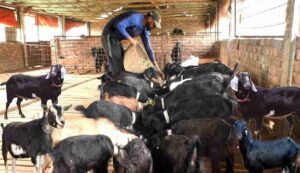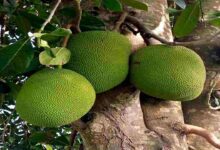Goat Farming: Farmers should rear these 5 breeds of goats, there will be a rain of money
Goat Farming: Raising goats may increase agricultural workers’ incomes while requiring less capital. There are five goat varieties that farmers may raise to provide income all year round. According to Dr. Ramsarik Prasad, the district animal husbandry officer, India is home to 20 different kinds of goats. The greatest breeds for producing milk and meat include Sirohi, Barbari, Beetle, Jamunapri, and Black Bengal. People may produce meat and milk by keeping goats with less expense and care.

Within two years, this breed has three offspring.
According to him, the Black Bengal breed of goat is more adapted to Jharkhand’s environment. In addition to being black, some goats have brown and white hair. Because it is black, it is known as Black Bengal. It is tiny in height, he replied. It has a sturdy body. Ears are little. The mature female weighs 15–18 kg, whereas the adult male weighs 18–20 kg. This breed has an excellent rate of reproduction.
It produces two to three children in a single lactation and three children in two years. At 8 to 10 months, the goat of this breed reaches adulthood, and at 15 to 16 months, it gives birth for the first time. From the perspective of producing meat, this kind of goat is particularly beneficial.
This goat breed produces one kilogram of milk per day.
The native regions of Central and West Africa are home to Barbary Nal goats. Priests transported them over to India. It is now widely distributed across Agra, Mathura, and the surrounding regions of Uttar Pradesh. In Jharkhand, people are also raising it by introducing goats from these areas. This goat is not very tall. It has a very well-built physique. There are tiny hairs on the body.
They have white markings on their bodies that are either brown or black in hue. It seems to be a deer. This kind of goat may be used for both milk and meat. One kilogram of milk is produced daily by this type of goat. It also has a very high fertility rate. It gives birth to two or three children in a single lactation and three children in two years. The mature female weighs 25–30 kg, whereas the adult male weighs 35–40 kg.
They may weigh between 55 and 60 kg.
Goats of the Beetle breed may be found in Punjab’s Gurdaspur area. They may also be found in Pakistan’s region next to Punjab. Jharkhand is another state where these goats are raised. Goats of the beetle breed may provide both meat and milk. This kind of goat produces one to two kg of milk per day. It typically gives birth to a single child and does so once a year. This breed’s mature male weighs between 55 and 60 kg, while the female weighs between 45 and 55 kg.
This breed may weigh up to 90 kg and produce 2 kilogram of milk. The plains of the Ganga, Yamuna, and Chambal rivers as well as the Etawah area of Uttar Pradesh are home to the Jamunapari breed of goat. It is now being grown in Jharkhand and other regions. Goats of this breed have large noses and dangling ears that measure 10 to 12 inches in length. It has a cylindrical body. The rear side of the thigh of these goats is covered in dense, long hair.
Adult males typically weigh between 70 and 90 kg, while females typically weigh between 50 and 60 kg. This type of goat typically produces 1.5 to 2 kg of milk per day. The majority of goats only give birth to one child during a lactation, and it gives birth to a child once a year. In our nation, goats of this breed are utilized to develop the breeds of other little goats.
This breed produces offspring twice a year.
Goats of the Sirohi breed are mostly found in Rajasthan’s Sirohi area. They may be found in Gujarat and Rajasthan’s border regions. Individual goats of this breed have large ears and short, dense body hair. The tail is curled, and its hair stands up straight. Every year, it gives birth to two children in a single lactation. This kind of goat is used to help other tiny breeds become better. This kind of goat may be raised for both milk and meat.

